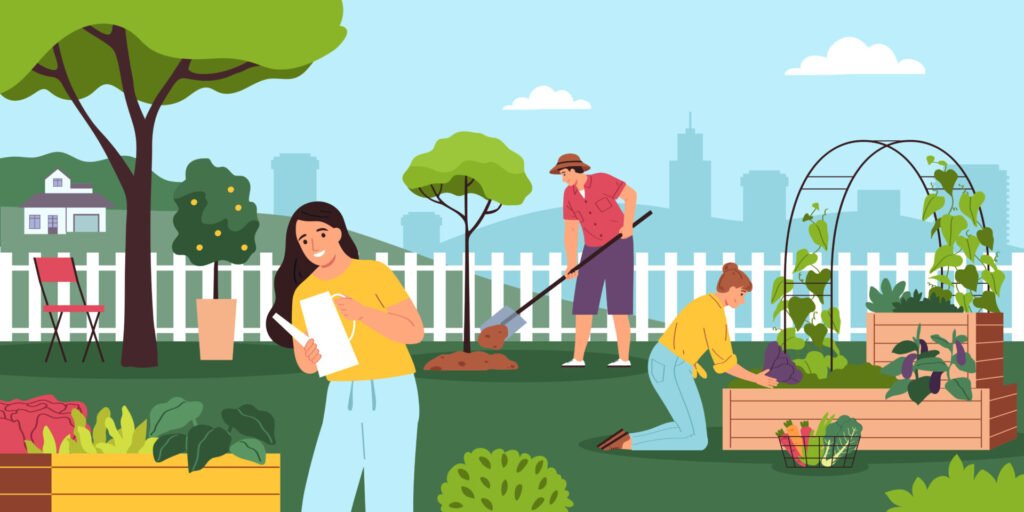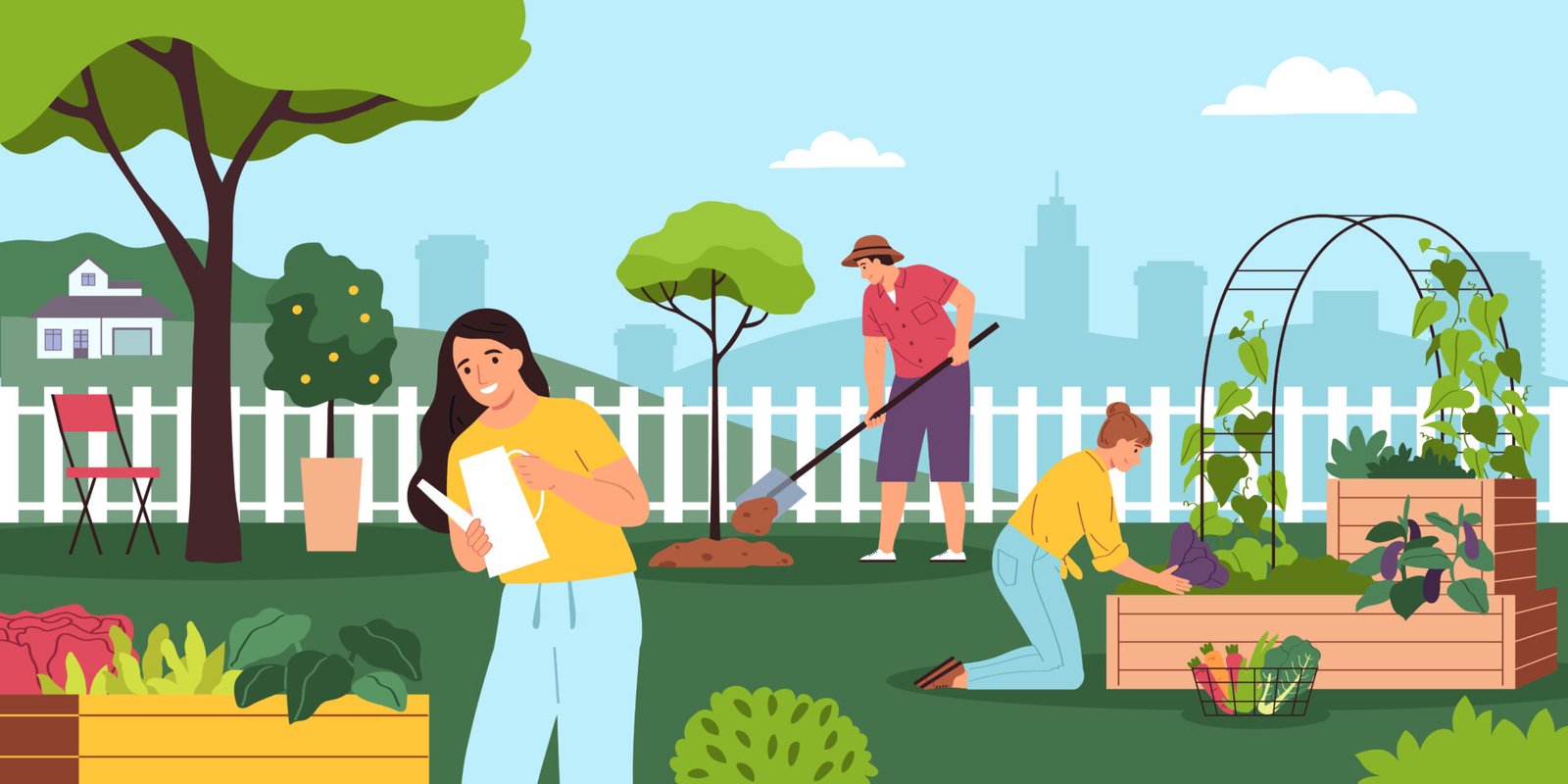Are you interested in starting a community garden but don’t know where to begin? Community gardens have become increasingly popular in recent years. They are shared spaces where people can grow fruits, vegetables, and flowers, and they bring communities together.
In this article, we’ll provide you with the information you need to start and manage a successful community garden.
Building and Managing a Community Garden: Tips and Tricks for Success
By reading this article, you will learn:
– How to find suitable land, gather support, secure funding, and plan/design a community garden
– How to organize garden tasks, encourage community participation, and deal with challenges
– How community gardens can promote sustainable living, healthy eating, and community building

What is a Community Garden?
A community garden is a shared space where people come together to grow vegetables, fruits, and flowers. They are typically located on public or private land and are managed by a group of volunteers. Community gardens are not only about growing fresh produce; they are also about building community, promoting sustainable living, and encouraging healthy lifestyles.
Starting a Community Garden
Starting a community garden requires planning, coordination, and community support. Here are some key steps to consider when starting a community garden:
Finding Suitable Land
- The first step is to find suitable land. Identify possible locations like vacant lots, parks, and schoolyards. When assessing the land, consider factors such as soil quality, accessibility, and sunlight exposure. You should also research legal requirements and zoning regulations to ensure that you can establish a garden in the chosen location.
Gathering Support from the Community
- Community support is essential for the success of a community garden. Build a team of volunteers and community partners who share your vision for the garden. Establish a shared vision and goals for the garden and develop a communication plan to reach out to the community. Involve community members in the planning and decision-making process to foster a sense of ownership and participation.
Securing Funding
- Establishing a community garden requires funding for tools, materials, and ongoing maintenance. Identify potential sources of funding such as grants, donations, and sponsorships. Craft a budget for the garden’s needs, develop a fundraising plan, and create grant proposals to secure the necessary funds.
Planning and Designing
- Plan and design your community garden. Create a garden layout and design, choose plants that are appropriate for the climate and community needs, and select tools and materials needed for maintenance and upkeep. Incorporate sustainable practices such as composting and rainwater harvesting into your garden design.
Managing a Community Garden
Managing a community garden requires ongoing organization and communication. Here are some key steps to consider when managing a community garden:
Organizing and Scheduling Garden Tasks
- Establish a system for assigning and tracking tasks and set up a regular schedule for maintenance and upkeep. Create a plan for garden emergencies and unexpected events, such as severe weather or pest outbreaks.
Encouraging Community Participation
- Community participation is essential for the success of a community garden. Provide opportunities for community members to get involved, such as volunteering, attending educational programs and events, and participating in harvests. Develop educational programs and events to promote gardening, cooking, and sustainability, and foster a sense of community and ownership among volunteers.
Maintaining the Garden and Ensuring Sustainability
- Maintaining a community garden requires ongoing attention to soil health, pest and disease management, and sustainable practices for water and energy use. Implement integrated pest management (IPM) principles to manage pests and diseases, and use sustainable practices such as drip irrigation and solar-powered lighting to minimize your garden’s environmental impact.
Dealing with Challenges
- Managing a community garden can present challenges such as conflicts among volunteers, vandalism, and security issues. Develop a plan for addressing these challenges, such as establishing clear rules and guidelines, communicating with local law enforcement, and involving community partners in addressing issues as they arise.
Personal Story: Overcoming Challenges in Managing a Community Garden
Managing a community garden can be challenging, especially when dealing with unexpected events. Last year, my community garden faced a major setback when a storm caused significant damage to our garden beds and fences. It was discouraging to see all of our hard work destroyed in just a few minutes.
However, we rallied together as a community and quickly got to work. We reached out to local businesses and community organizations for donations of materials and tools. We also organized a volunteer day to repair the damage and rebuild our garden beds.
Through this experience, we learned the importance of having a plan in place for emergencies. We developed a disaster preparedness plan and established a fund for emergency repairs. We also made sure to communicate regularly with our community partners and volunteers about any potential risks or concerns.
Despite the setback, our community garden has continued to thrive. We’ve even expanded our garden to include more plots and new crops. This experience taught us the importance of resiliency and collaboration in managing a community garden.
Community Garden Activities and Events
Community gardens are more than just places to grow food and flowers – they are also spaces for community activities and events. Here are some ideas for community garden activities and events:
Activities and Events
- Community gatherings, such as potlucks and picnics
- Workshops on gardening, cooking, and sustainability
- Art and music events
- Plant sales and seed swaps
Organizing Events and Activities
When organizing events and activities, plan and promote them effectively to maximize attendance. Coordinate with community partners and volunteers, and evaluate the success of events to make improvements for next time.
Benefits of Community Garden Activities and Events
Community garden activities and events can bring people together across diverse backgrounds, provide educational and cultural enrichment opportunities, and promote healthy living and environmental stewardship.
| Activities and Events | Benefits |
|---|---|
| Community gatherings, such as potlucks and picnics | Bring people together across diverse backgrounds |
| Workshops on gardening, cooking, and sustainability | Provide educational and cultural enrichment opportunities |
| Art and music events | Promote community engagement and creativity |
| Plant sales and seed swaps | Increase access to diverse plant varieties |
Promoting Sustainable Living Through Community Gardens
Community gardens have the power to promote sustainable living and healthy lifestyles. Here are some ways that community gardens can make a positive impact:
Promoting Environmental Sustainability
- Community gardens can reduce food waste and carbon footprint, provide habitat for pollinators and wildlife, and reduce urban heat island effect and improve air quality.
Promoting Healthy Eating and Lifestyles
- Community gardens can increase access to fresh and nutritious produce, encourage home cooking and meal sharing, and promote physical activity and stress reduction.
Fostering Social Connections and Community Building
- Community gardens can encourage volunteerism and civic engagement, foster intergenerational relationships and mentorship, and create a sense of place and belonging in the community.
Here’s My Take…
As someone who has been involved in community gardening for many years, I can attest to the benefits that community gardens provide. Over the years, I have seen community gardens bring people together, promote sustainable living, and encourage healthy lifestyles. Community gardens not only provide fresh produce, but they also provide a sense of community and belonging. I encourage everyone to get involved in a community garden and experience the benefits for themselves.
Conclusion
Community gardens are important spaces for promoting sustainable living and community building. By following the tips and tricks outlined in this article, you can start or support a community garden in your own community. Remember to involve community members in the planning and decision-making process, promote community participation and ownership, and incorporate sustainable practices into your garden design. Together, we can create a healthier, more sustainable future for ourselves and our communities.
Insider Tip: When starting a community garden, it’s important to involve local businesses and organizations. They can provide support and resources that can help make your garden a success.
FAQs
Q: What are community gardens and who can participate?
A: Community gardens are shared spaces where anyone can grow plants, regardless of skill level or age.
Q: How do community gardens benefit the environment?
A: They help reduce carbon emissions, improve air quality, and promote biodiversity.
Q: What are the steps to start a community garden?
A: Find a suitable location, secure funding, gather volunteers, and create a plan for maintenance.
Q: Who is responsible for maintaining a community garden?
A: The garden is typically maintained by volunteers who share the responsibility for upkeep.
Q: How can community gardens bring people together?
A: They provide a space for people to connect, learn from one another, and share their love of gardening.
Q: What if I don’t have any gardening experience?
A: Community gardens are open to people of all skill levels, and many offer workshops and training for beginners.








